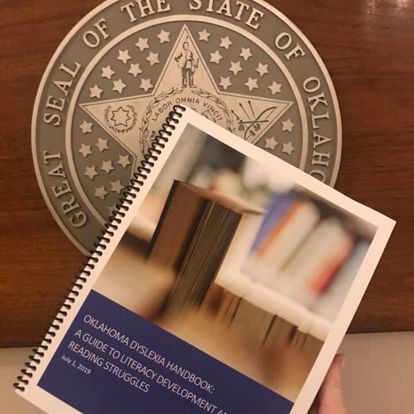What is Dyslexia?
Dyslexia is a specific learning disability that manifests in difficulty in reading, spelling, and writing. A person with dyslexia is often of average or above average in intelligence. The best formal definition of Dyslexia is from the International Dyslexia Association from 2002 and is used by the Oklahoma State Department of Education.
Dyslexia is a specific learning disability that is neurological in origin. It is characterized by difficulties with accurate and/or fluent word recognition and by poor spelling and decoding abilities. These difficulties typically result from a deficit in the phonological component of language that is often unexpected in relation to other cognitive abilities and the provision of effective classroom instruction. Secondary consequences may include problems in reading comprehension and reduced reading experience that can impede the growth of vocabulary and background knowledge.
What dyslexia may look like
Preschool
- Speech-language delays
- Mispronunciations
- Directionality
- Difficulty with Letters names
- Difficulty recognizing and producing rhyme
Elementary
- Difficulty
- remembering names/shapes,
- sounds of letters
- generating rhyming words
- Spelling errors that reflect difficulty with sound/symbol associations
- Frustration in school
- Complains about reading
.
Older students
- Significant difficulty reading and spelling multisyllabic words, often omitting entire syllables as well as making single-sound errors
- Difficulties with reading comprehension and learning new information from the text due to underlying word recognition difficulties
- Reports unusually long hours spent doing homework
Learn more from the National Center for
Improving Literacy’s (NCIL) website on understanding dyslexia compared to typical readers.
Oklahoma State Department of Education
The Oklahoma State Department of Education (OSDE) does recognize dyslexia. In addition to recognizing dyslexia, OSDE is providing support to Oklahoma schools and educators.
OSDE provides:
- Dyslexia Professional Development Modules
- Maintains the Oklahoma Dyslexia Handbook
- Guidance for implementation of dyslexia screening

So it may be dyslexia. What’s next?
Currently, in Oklahoma schools, dyslexia is under-identified. You will need to be your child’s advocate at school. The International Dyslexia Association (IDA) Dyslexia Handbook: What Every Family Should Know is an excellent place to start a family’s advocacy journey. The IDA Handbook will review valid assessments for dyslexia and what effecting teaching looks like for a student with dyslexia. Knowing the signs of dyslexia and recognizing them in your child will leave you wanting to know if it is indeed dyslexia. The Oklahoma Dyslexia Handbook can be a valuable resource for families.
Oklahoma kindergarten through third-grade students are screened for reading difficulties as part of universal screening through the Reading Sufficiency Act (RSA). Beginning in the 2022-2023 school year, Oklahoma students not meeting the benchmark for RSA screening will also be screened for dyslexia. Both of these screenings are intended to provide families and educators insights into the areas of difficulties in reading. The identified areas will be used to build an Individual Plan of Reading Instruction (IPRI) to assist in improving students’ reading ability. If a student does not improve with intervention, the student may need to be referred for a special education evaluation.
